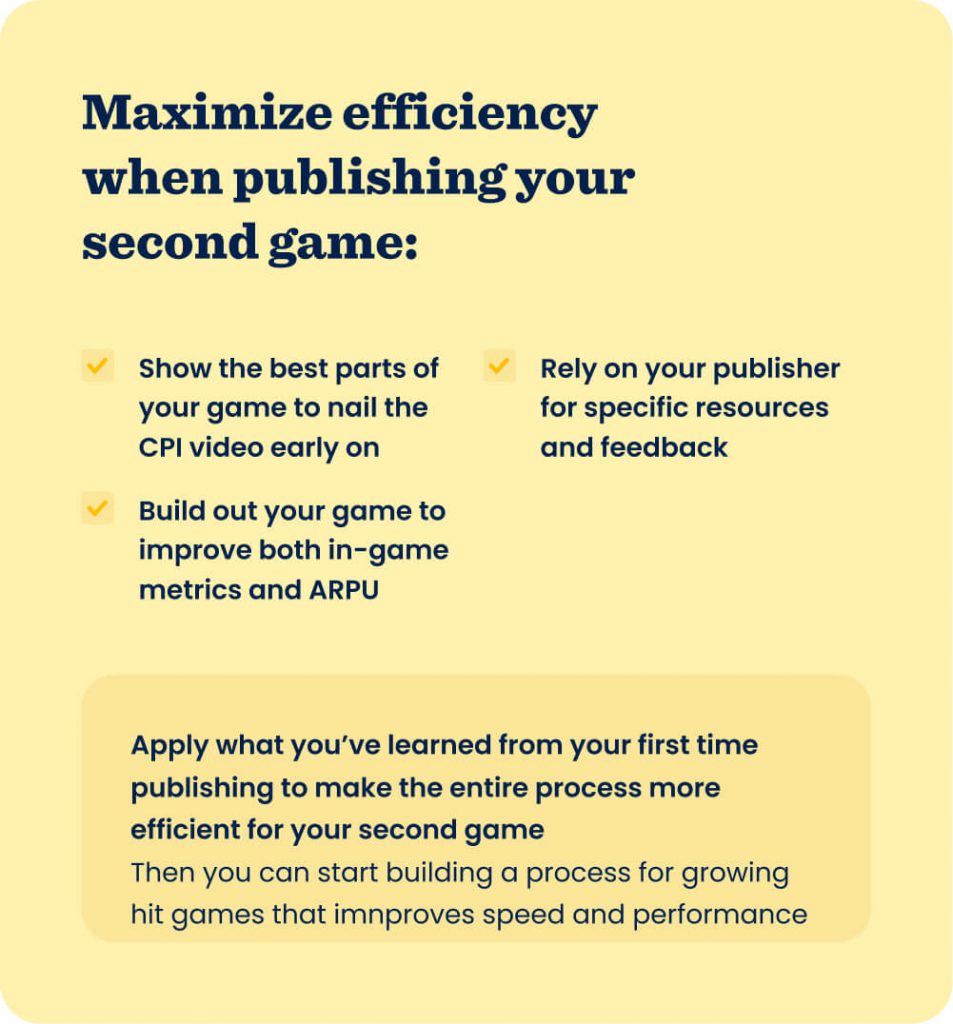There’s nothing quite like the feeling of publishing your first game. That is, until you publish your second one. The first time you go through the publishing process is often a learning curve at each stage. Testing your prototypes to find the best product-market fit, working with your publisher to grow the game out and boost in-game metrics, then implementing ads and optimizing your monetization strategy all present new challenges and learning opportunities.
So imagine if you weren’t the new kid on the block anymore and you knew what to expect at each stage of publishing to grow another game into a hit more quickly and efficiently. That’s what Nir Regev, Director of Publishing at Supersonic, is discussing here with real examples from developers that have published more than one hit game with us. In this article, learn what to expect the second time around when growing your next hit game with a publisher so you can maximize efficiency at each step.

Understanding how to show the best parts of your game in a CPI video
Many first-time developers build out too much of their game during prototyping, but the priority at this stage is testing if your game is a product-market fit. For the second time around, use what you know about the full funnel of publishing so that you can think beyond ideation to focus on key elements like the game’s goal, mechanics, and story - these are the parts that hook users in the CPI video. Seeing the parts of your first game that kept users playing and the elements of successful creatives can inform your decision-making about which features to highlight in the prototype video that improve clarity and lower CPI.
Beyond game features, apply the creative best practices you’ve learned along the way, too. Often, first-time developers try many different variations of a CPI video until they find one that works. But designing an initial video that incorporates the features of previous winning creatives can help boost performance from the get-go and make the testing phase more efficient. If you noticed that changing the camera angle to first-person during the iteration phase of your first game helped unlock CPI, for example, you should try different camera angles immediately in your second game’s CPI videos.
When Garawell Games published their second game, Color Match, their initial prototype video had a CPI of $0.53.
“From our previous publishing experience with Supersonic, we knew the difference that the right video could make. So we started iterating on the CPI video and testing new versions.”
- Nebih Başaran, CEO and Founder at Garawell
They applied what they learned about CPI video testing and iterating from publishing their first game and began trying new versions - they quickly found one that lowered CPI to $0.29.
Building out your game with monetization in mind
First-time developers publishing their games and building them out are likely focused only on improving in-game metrics. After adding ads, though, users often behave differently and this impacts in-game metrics. The second time around, you can build out your game while keeping these metrics and your monetization strategy in mind as you try to increase KPIs for both, like retention and ARPU. Design each level, confirm your game’s progression, and establish the difficulty curve that helps you maintain in-game metrics even after implementing ads. For example, for your first game you may design levels that are 50 seconds long. But the second time you’re publishing, you understand that shorter levels might give you more opportunities to show end-level ads like interstitials and rewarded videos. So you build your second game with shorter levels from the get-go, saving development time and resources later on.
Another important part of building out your game is A/B testing. Take note of which A/B tests made the biggest impact on your previous game so you can prioritize these and optimize your new title more efficiently. You can also use the Supersonic LiveGames platform to get insights into which A/B tests moved the needle even after your first game launched and could inform your new game’s testing strategy.
With Escalators as their second title, Black Candy felt more prepared to run the right A/B tests, and to do so more quickly. Almost every test they ran was a success - the new elements performed better than the control group and helped improve KPIs like LTV and APPU while keeping CPI stable so the game could scale profitably.
“Working with Supersonic again felt seamless and even more efficient than the first time. This time, we knew the road map of publishing and what to expect at each stage, like which A/B tests to prioritize.”
- Bayasaglan Lkhamdorj, Co-founder of Black Candy
After making these optimizations, the game reached the top 20 on both app stores, achieved millions of downloads, and had impressive in-game metrics that indicated LTV was high.
Getting the most out of your publishing partner
The relationship with your publisher tends to look different from your first game to your second. The first time around, they’re likely a general resource guiding you through each stage, helping with everything from level design to creatives. The second time, you’re familiar with the process and are empowered with the knowledge and tools you can apply to your next title.
On both sides, there’s a better understanding of expectations because both you and your publisher know what worked well last time - this creates a more cooperative and seamless publishing process. Now, you can look to your publisher for more specific resources, feedback, and support. With your first game, for example, your publisher may have learned you have a lot of development experience and can make game changes quickly. But, you have a lean team with less experience in UA. So the second time around, they may be more hands-off with game design suggestions and more proactive with creative optimizations.
With Garawell Games, they looked to Supersonic for full support across design, monetization, and creatives for their first game, Bridge Race. When they published their second game, they asked for more specific feedback while applying their learnings and best practices.
“Working with Supersonic again was a great experience - and this time, our communication and feedback loop was even more flawless.”
- Nebih Başaran, CEO and Founder at Garawell
During marketability testing, for example, they spoke directly with the Supersonic team for tips on improving their CPI video.
Establishing a process for making hit games
With each title you publish, keep building up your database of best practices and knowledge, then apply these to your next game for a more efficient and quick publishing process. As you continue to do this again and again, you can standardize certain steps, like building a template for runner games based on what you’ve seen work for your previously published titles - this saves valuable time as you work on your next runner prototypes.
In the hyper-casual industry, staying ahead of competitors and capitalizing on timely trends is crucial for success. The top charts and trends are shifting all the time, so speed is of the essence. Gathering as many learnings as possible each time you publish a game can help you create a process for future titles that improves both speed and performance.
Let's put these tips to good use
Publish your game with Supersonic



